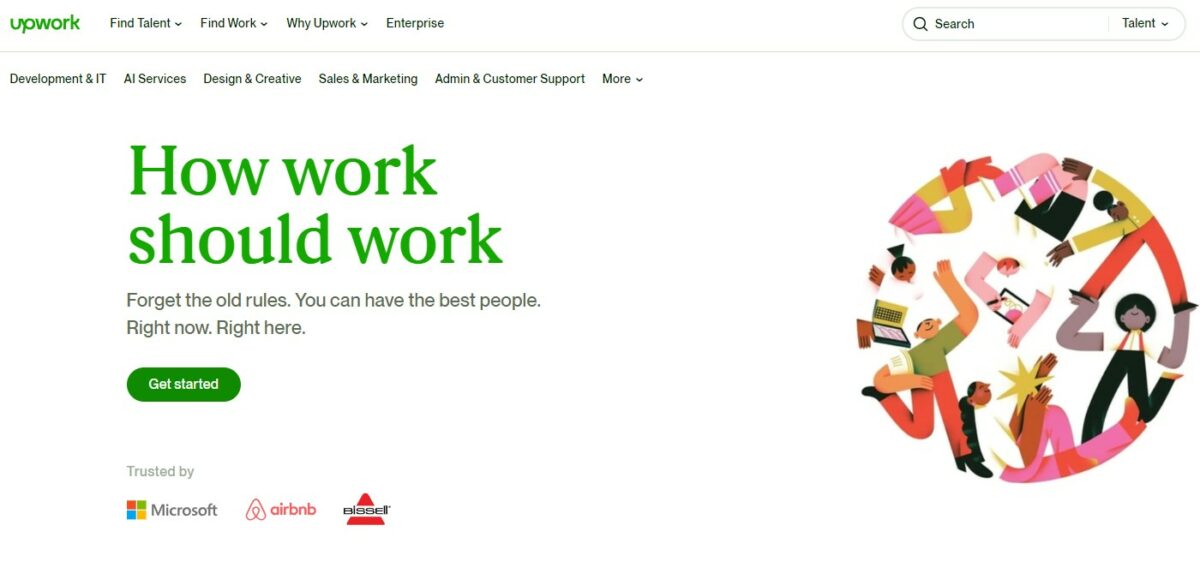The term gig economy is a reference to the number of freelancers and freelance jobs undertaken.
In the past, freelancers were tradespeople, such as plumbers and electricians.
You may also have come across consultants and entrepreneurs, looking for alternatives to the rat race.
It was fair to say that the gig economy was a small part of the global economy.
However, as the following gig economy statistics show, times have changed.
Today, millions of people across the planet enjoy the flexibility of working from home on their own terms, undertaking jobs they choose.
Granted, it’s more complicated than simply attending a workplace every day.
However, the rewards are also higher, including more control over your time, workload, and even the location where you complete your work.
Interest in the gig economy has been growing for years, although there is little doubt that the global pandemic caused a surge in interest.
With lockdowns, job uncertainty, and a desire for better work-life balance, many people have turned to gig work.
It can help people make ends meet or provide an alternate income.
Being a gig worker means giving up the traditional 9-5 style job and the secure monthly paycheck.
Instead, you’ll be looking for gigs, arguing for the right price, and probably won’t get employer-covered benefits.
But, the rewards are worthwhile, not just financially but you’re likely to have better health due to lower stress levels and a better mental attitude to life.
Let’s take a look at some of the top statistics:
Post Contents
- 1 Key Statistics
- 2 Top Gig Economy Statistics in 2024
- 2.1 1. 36% Of The US Workforce Worked Gigs In 2020
- 2.2 2. 16% Of US Adults Have Earned Via Gigs
- 2.3 3. The Gig Economy Accounts For 5.7% Of US GDP
- 2.4 4. Over 90% Of Americans Would Try Gig Work
- 2.5 5. 60% Of Independent Workers See Themselves As Flexible
- 2.6 6. Better Work-Life Balance Is The Driving Force In Switching To Gigs
- 2.7 7. 37% Of Gig Workers Are Millennials
- 2.8 8. 53% Of US Independent Workers Are Male
- 2.9 9. Gig Workers Earn Less Money Than Traditional Jobs
- 2.10 10. Three Quarters Of Gig Workers Are White
- 2.11 11. 54% Of Gig Workers Don’t Have Additional Benefits
- 2.12 12. 48% Of Millennials Are Using Gig Platforms
- 2.13 13. 14% Of Gig Workers Are Employed By The Government
- 2.14 14. AI And Blockchain Are The Highest Paying Gig Work
- 2.15 15. 90% Of Americans Feel The Education System Should Prepare Them Better For Gig Work
- 2.16 16. The Average Gig Worker Earns Between $7 And $15 An Hour
- 3 Summing Up
Key Statistics
- 36% of the US workforce worked gigs in 2020
- 16% of US adults have earned via gigs
- The gig economy accounts for 5.7% of us gdp
- Over 90% of Americans would try gig work
- 60% of independent workers see themselves as flexible
- Better work-life balance is the driving force in switching to gigs
- 37% of gig workers are Millennials
- 53% of US independent workers are male
- Gig workers earn less money than traditional jobs
- Three quarters of gig workers are white
- 54% of gig workers don’t have additional benefits
- 48% of Millennials are using gig platforms
- 14% of gig workers are employed by the government
- AI and blockchain are the highest paying gig work
- 90% of Americans feel the education system should prepare them better for gig work
- The average gig worker earns between $7 and $15 an hour
Top Gig Economy Statistics in 2024

1. 36% Of The US Workforce Worked Gigs In 2020
According to a recent Zippia survey as many as 59 million Americans undertook at least one gig during 2020.
This may be a higher percentage than normal as it was while lockdowns were in force.
It’s the equivalent of 36%, over one-third, of the US workforce.
What is particularly interesting is the subsequent climb in gig economy workers.
A further study showed that an additional 13 million workers, making a total of 72 million Americans, completed some gig work during 2021.
That’s a sizable number of people looking to invest in themselves for the future instead of a standard workplace job.
The statistics also revealed that 52% of people who plan on changing their job intend to pursue a freelance career with gig work.
The survey also found that 29% of US workers are considered part of the gig economy as their primary job now has an alternative working arrangement.
This has become common since the pandemic turned everything upside down.
Of the 29%, nearly a quarter are in the care industry and 49% are part time workers.
(Zippia)
2. 16% Of US Adults Have Earned Via Gigs
The same survey from Zippia looked at how many US adults have ever used the gig economy but don’t consider themselves to be regular users of gigs.
The answer was an impressive 16% of people had earned money via gigs at some point during their life.
In fact, 9% of those surveyed admitted to earning money from gigs during 2021, showing just how common it is becoming to use the gig economy.
Estimates suggest that by the end of 2023, as many as 52% of the US will have some experience with the gig economy and completed at least one freelance/gig job.
For further comparison, the US independent workforce consisted of 38 million people in 2020.
By 2021 it had reached 51 million people.
In both cases just under half were considered occasional workers, a small percentage part-time, and a third were full-time.
(Zippia)
3. The Gig Economy Accounts For 5.7% Of US GDP
In 2022 US GDP was worth 25462.70 billion dollars.
The gig economy is a small part of this, contributing just 5.7% of this GDP.
That’s around $1.21 trillion.
It may be a small amount of the GDP but it’s still a large number, especially when you consider it shared by roughly a third of the population.
In other words, there is some serious financial potential in the gig economy, although not everyone will see or benefit from it.
Interestingly, the average gig worker will work between 40-49 hours a week, more than if they worked a conventional job.
(Zippia)
4. Over 90% Of Americans Would Try Gig Work
Until recently gig work has always been in the minority.
Most people wouldn’t trade the stability of a traditional job for the uncertainty of gigs.
However, many people reevaluated their views during the pandemic.
In the first instance it gave people an opportunity to look at their work-life balance.
The lockdowns and other restrictions were also damaging to the economy, many people found themselves unemployed.
While not everyone has committed to the gig economy, a recent survey showed a staggering 90% of Americans would be willing to try this alternative.
Interestingly, this statistic is reflected in other countries, such as India and Mexico where 97% of adults would try freelance gig work.
Naturally, younger people are more inclined to try gigs than older people.
In general, those approaching the end of their careers have more to lose and less willingness to try something different.
(Manpower Group)
5. 60% Of Independent Workers See Themselves As Flexible
As an indicator of how satisfying the gig economy is, a recent survey found that 85% of the freelance workforce in the US could see themselves continuing in their line of work for the next five years.
That’s not the only fact that reflects how content gig workers are.
The survey showed that 60% of independent workers believe their work is flexible and can fit around their lifestyle commitments as opposed to the other way around.
The survey found that just 27% of people in traditional jobs felt the same way.
Alongside this, nearly half of all gig workers, 47% to be precise, are happy with their working hours and working schedule.
Again, this isn’t the case for traditional workers where just 34% felt the same way.
(Forbes)
6. Better Work-Life Balance Is The Driving Force In Switching To Gigs

Work-life balance has always been an important factor in job decisions.
The balance isn’t the same for everyone and your interpretation of work-life balance is likely to change as you age.
However, an improvement in work-life balance seems to be a driving force for many people.
A recent survey found that 70% of respondents took a job in the gig economy to improve their work-life balance.
That’s not the only facts this survey uncovered.
It found 62% of respondents wanted to be able to define their own working hours, 49% of people wanted to become their own boss, and 46% of people felt it was important to be able to choose projects which really appealed to them.
Other top reasons to switch to the gig economy include more time with the family, reducing costs such as commuting, and improving personal health.
Others stated they wanted to avoid office politics and do their part to help the environment.
What is clear is that the gig economy is becoming very attractive.
658% of those asked stated they wanted to control when to work.
56% of respondents felt the gig economy allowed them to decide how hard to work.
(Flexjobs)
7. 37% Of Gig Workers Are Millennials
Younger people are more attracted to alternate job arrangements.
This is largely because they have been brought up with digital technology and are generally more comfortable taking risks.
The proof is in the latest survey by MBO Partners.
It found that 37% of gig workers were Millennials and 35% were baby boomers.
Millennials are those born between the early 1980s and the mid-1990s.
They were brought up without the internet but discovered it as they moved into the world of work.
That may be why they are comfortable with gig work.
The percentage of baby boomers interested in gig work is slightly more surprising.
Baby boomers were born between 1946 and 1964, long before the internet became mainstream.
Today, they would be aged between 50-70.
It’s likely their interest in gigs is tied to boredom in retirement or a need to try something different as it can be harder to secure regular jobs.
(MBO Partners)
8. 53% Of US Independent Workers Are Male
The most recent statistics show that 53% of US independent workers are male.
That means males are most common but only by a little.
47% of US gig workers are self-employed and women.
This illustrates how the country is continuing to move towards equality in the workplace.
The survey also found that many of the women are moving into gig work as a reaction to discrimination in the workplace.
They are less likely to be harassed when working for themselves.
(MBO Partners)
9. Gig Workers Earn Less Money Than Traditional Jobs
There are some gig workers who do extremely well for themselves, securing high-paying gigs and earning large sums of money.
Unfortunately, according to the latest figures, this is the minority.
In most cases; gig workers earn less than the equivalent traditional worker.
They also need to put in more hours as they spend time locating their next gig.
The Prudential study found the average salary for an employee is $62,500.
In contrast, the average independent worker gets an average of $36,500.
Interestingly, gig workers tend to earn more as they age.
Millennials have an average salary of $27,500, Generation X is likely to bring home $36,300, and Baby Boomers can attract $43,600.
Baby Boomers generally work less hours than Generation X.
It should be noted most gig economy workers will work fewer hours than a traditional worker and they don’t need to commute.
This is part of the reason there is a seemingly large discrepancy between earning levels.
(Prudential)
10. Three Quarters Of Gig Workers Are White
The majority of people living in the US are white.
In 2020 the Non-Hispanic white population of the US dipped below 60% for the first time.
The survey showed that 58% of Americans are Non-Hispanic whites.
In fact, the Hispanic and Latino populations grew by 23%, the Asian population by 35%, and the black population by 5.6%.
This ethnic split makes it interesting that 74.6% of gig economy workers are white and just 17.1% are African Americans.
Even the growing Asian and Hispanic populations don’t make a huge impact on the gig economy.
The Asian percentage is 5.8% and Hispanic 16.4%.
These percentages add up to over 100% because some people have multiracial backgrounds.
(USA Facts)
11. 54% Of Gig Workers Don’t Have Additional Benefits
Gig workers automatically don’t have access to health benefits and other perks that come with traditional jobs.
That’s because many gig workers are self-employed.
In other words, they need to pay for these benefits themselves.
This isn’t the case for all gig workers and some are still employed but working an alternative arrangement to standard.
However, even these appear to miss out on benefits.
The majority of gig workers with benefit access have got it through an employed spouse.
It’s estimated that just 40% of gig workers have employer-sponsored medical insurance, 25% have access to dental care, 20% can get life insurance, and just 5% benefit from short-term disability insurance.
In other words, independent workers are missing out on a lot of healthcare and many can’t afford to invest in their own insurance.
It doesn’t appear to put people off becoming independent workers but it could result in a dramatic increase in health issues in the future.
(Prudential)
12. 48% Of Millennials Are Using Gig Platforms

Gig platforms have grown immensely in popularity in recent years.
There are plenty to choose from, some of the most popular are Fiverr and Upwork.
These platforms allow businesses and individuals to list gigs.
All a freelancer needs to do is create an account and apply for the gigs that they like the look of.
If the advertising and the freelancers like each other an agreement is made.
The advantage of platforms is that the funds are placed in escrow with the platform.
It makes the entire transaction safer as the buyer verifies the work before the funds are released but the freelancer knows the funds are ready and waiting.
Millennials have seized the opportunities offered by gig platforms.
In fact, 48% of millennials use gig platforms.
In contrast, just 35% of Generation X and 19% of Baby Boomers use these platforms.
(Prudential)
13. 14% Of Gig Workers Are Employed By The Government
This statistic is perhaps the most surprising of all.
The government has always been keen on saving money and the gig economy has proved to be an excellent way for them to do so.
As with many employers, the government can hire professionals and get a high-quality job completed for less than the cost of employing staff.
In addition, they save on employee benefits.
Once you realize this, it’s hardly surprising that 14% of all gig workers are actually employed by the government.
There are other large players in the gig economy.
Professional and business services account for 10% of the gig economy, education and health account for the same.
Manufacturing and construction account for 9% of the industry while information has an 8% share.
Trade, transportation, and utilities all have a 7% share, with leisure and hospitality holding a 6% share and tech taking a minimal 5% share.
The government may employ the largest number of gig workers but it is definitely popular across all industries.
(Statista)
14. AI And Blockchain Are The Highest Paying Gig Work
A recent survey looked at which industries paid the most when recruiting gig workers.
Unsurprisingly, AI, where a huge amount of funds is currently being invested, came top.
According to the survey, the average AI freelancer will earn $115.06 per hour!
That’s significantly more than those working in blockchain technology who get an average of $87.05 per hour.
Both are desirable hourly rates.
Robotics gigs also pay well, averaging $77.46 per hour and hacking, (specifically protecting systems against hacking) gets an average $66.33 per hour.
Other industries do surprisingly well.
A gig worker in cryptocurrency can get $65.37 per hour, in virtual reality $50.08 per hour, and even an Instagram marketer can get $31.23 an hour.
In short, if you’re just looking into gig economy opportunities, consider training in one of the above first.
(The Balance Small Business Survey)
15. 90% Of Americans Feel The Education System Should Prepare Them Better For Gig Work

Upwork is one of the biggest platforms in the gig economy.
It’s also one of the most popular and, according to its own statistics, 30% of Fortune 500 companies use Upwork to find talent.
The platform conducts an annual survey to assess how the gig economy is doing and what the gig workers feel would benefit them.
Interestingly, 90% of gig workers feel that the education system doesn’t do enough to prepare people for gig work.
Unfortunately, the education system remains in the past and continues to teach traditional subjects in a traditional manner.
This has worked well for many years but the digital revolution has changed everything.
Today, people need to know how to work for themselves, how to attract clients, and how to negotiate with those clients.
90% of US freelancers feel the education system should do more in this area.
A further 78% feel that soft skills, such as those that could be taught at school, are as important for success as technical skills.
(Upwork)
16. The Average Gig Worker Earns Between $7 And $15 An Hour
A recent survey by Zety found that the average salary for a gig worker in the US is $49,751.
That’s respectable.
However, it’s a result of a lot of hard work and hours as the average gig worker gets paid between $7 and $15 per hour.
The truth is 61% of gig workers feel they would be better paid in a traditional role.
However, the appeal of freelance gig work means they don’t return to traditional roles.
Don’t forget, being a gig worker means spending time finding the right gig, applying for it, and negotiating prior to contract.
That all takes time and the gig worker isn’t paid for this.
(Zety)
Summing Up
The above gig economy statistics make interesting reading.
They paint a picture of an industry that is thriving.
It’s certainly true that the industry has grown dramatically in recent years.
However, many gig workers have turned to this economy to help them survive the fallout of the global pandemic.
The truth is that most gig workers don’t even earn the average salary.
If this issue isn’t addressed the statistics for the gig economy could look much worse in a few years.
In short, if you’re thinking of joining the gig economy, take the time to assess your skills, improve them, and then make sure you charge what you’re worth.
That will help you, and the gig economy, to be a success.






























